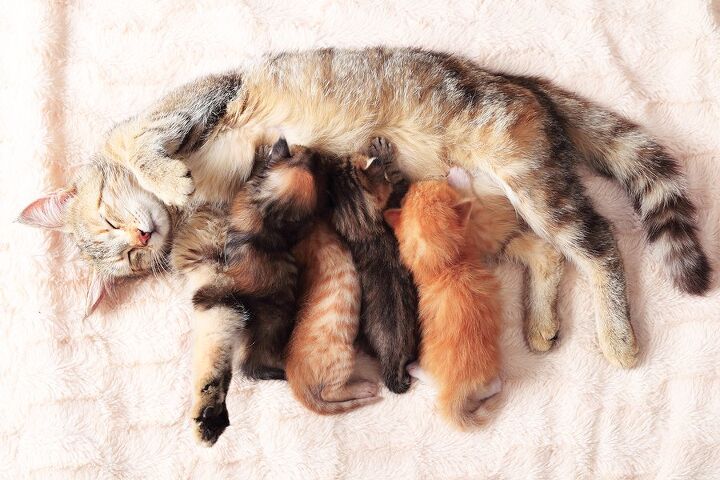Feline Pregnancy: How To Care For A Pregnant Cat

A pregnant cat will need extra care to help her get through her pregnancy and give birth to a healthy litter of kittens. Here is a short guide to feline pregnancy, along with tips on keeping the mama cat healthy and happy.
Feline Gestation
The average feline pregnancy lasts an average of 65 days, with cats typically giving birth between days 63 and 69, though Siamese will usually give birth around 71 days. If kittens are born prior to day 60, though, they’ll often be too premature to survive.
Related: How To Prepare Your Home For A New Kitten
A Boost in Nutrition
Just like pregnant women, pregnant cats need extra nutrition because they’re eating for themselves and their litter of kittens. Because your cat will need a lot more calories than usual, and these calorie requirements will continue to increase as the pregnancy progresses, feed her a kitten formula food that has extra nutrients and calories when compared to regular adult formulas.
In addition to changing the formula that you’re feeding, you should also expect to increase the amount that you’re feeding, especially as your cat nears the end of her pregnancy.
Morning Sickness in Cats
A pregnant kitty may sometimes experience morning sickness, and this usually occurs within the 3rd or 4th week of the pregnancy as a result of changes in hormones and the distention of her uterus. She may be apathetic and may choose not to eat because she ends up vomiting. This should only last a few days, but if the cat doesn’t eat or drink for over two days, have her checked by a vet.
Related: The Stages of Kitten Development
Provide a Spot for Giving Birth
Shortly before your cat is ready to give birth, give her a box or a similar type of shelter where she can go through the birthing process and take care of the kittens. Make it comfortable by lining it with towels or soft blankets, as these are easy to replace or clean. And place the shelter in a familiar and quiet spot, letting your cat know that it’s there for her to use.
Despite making the effort to give your cat a safe spot to give birth, she may opt for a different location. In this case, you can gently move her kittens to the shelter you made after they’re born. The mother won’t injure or abandon her babies if you handle them, so you can certainly touch them.
Signs Your Cat Needs Help
Your cat may be able to deliver her litter without any help, but keep an eye out for these warning signs that she needs prompt veterinary attention:
- She’s experiencing contractions but hasn’t given birth to a kitten in 15-20 minutes
- Part of a fetus or part of the placenta is protruding from the vulva but she’s unable to pass a kitten within one to two minutes
- Over two hours pass between kittens
- After giving birth, the mother has a discharge from the vulva that’s foul smelling
- After giving birth, the mother isn’t eating normally, is acting abnormally, has diarrhea, is vomiting, or has seizures or tremors
Work Closely with Your Vet
When caring for a pregnant cat, as well as the kittens she’ll give birth to, it’s a good idea to stay in touch with your veterinarian. He can ensure the feline pregnancy is going well and that the kittens are healthy and developing well. He’ll know how to palpate her abdomen without risking miscarriage as well, so leave that to him.
Having this expert support system both during and after the pregnancy will make the task easier and ensure the wellbeing of your kitties.
A Word about Breeding
It’s important to note that there is an overpopulation of cats in shelters and on the streets all over the world, so only breed cats if you’re an experienced, responsible breeder and you really know the breed of cat you’re caring for. You shouldn’t be letting your cats mate just because you want to see the birth process, get a free kitten, or sell the kittens for profit. Instead, please consider spaying and neutering your cats, and when ready to bring a kitten into your home, contact local shelters and rescues so you can adopt and save a life.

Lisa Selvaggio is a freelance writer and editor, and our resident cats-pert, with certifications in pet nutrition and pet first aid. She enjoys producing content that helps people understand animals better so they can give their pets a safe and happy home.
More by Lisa Selvaggio























